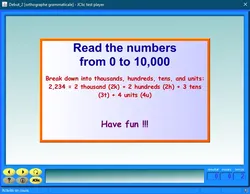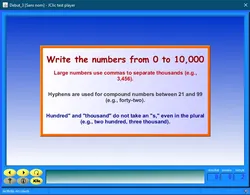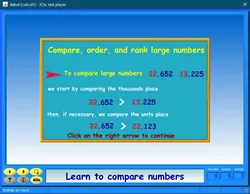Numeration Exercises for Grade 3 Students
Advanced Numeration Exercises for Grade 3 Learners
Welcome to a collection of interactive online math activities designed to help Grade 3 students deepen their numeration skills. These exercises cover a broad range of number-related concepts—from recognizing and writing numbers in both digit and word form, to decomposing numbers up to 10,000, and comparing large numbers up to 99,999. By engaging with these tasks, learners refine their understanding of place value, strengthen their ability to connect various representations of numbers, and master comparison symbols in challenging contexts.
Exercise 1: Connecting Numeric, Written, and Decomposed Forms (0 to 10,000)
Focus: Reinforcing the link between numbers written in digits, their word forms, and their decomposition into units, tens, hundreds, thousands.
- Type 1: Given a numeric form (e.g., 1,236), students choose the correct written-out form from three possible options.
- Type 2: Presented with a decomposition (e.g., 1k 2h 3t 6u), learners match it to the correct numeric form (e.g., 1,236).
- Type 3: Students pair numeric and written forms to rebuild matching “couples,” reinforcing their dual representation skills.
- Type 4: A written form is displayed, and students must click on the correct numeric form from nine possible choices.
Exercise 2: Writing Numbers and Decompositions in Different Forms (0 to 10,000)
Focus: Strengthening the ability to convert between word form, numeric form, and decomposed form.
- Type 1: Given a word form, learners type its numeric equivalent (e.g., “one thousand two hundred thirty-six” → 1236).
- Type 2: Presented with a decomposition (e.g., 1000 + 500 + 20 + 5), students type the resulting number (1525).
- Type 3: A numeric form is given, and students type out its word form, reinforcing their reading and writing of large numbers.
Exercise 3: Comparing and Ordering Large Numbers (10,000 to 99,999)
Focus: Applying comparison symbols (>, <, =) to five-digit numbers and arranging them in ascending order.
- Type 1: Four pairs of large numbers are shown with a blank space between them. Students select the correct comparison symbol and click to place it. Immediate feedback guides them to correct any mistakes.
- Type 2: Equations with a missing number (e.g., "25,005 > ?") challenge students to pick the right number from four options.
- Type 3: Students rearrange a set of five large numbers into ascending order, helping them understand relative magnitudes at a glance.
Exercise 4: Further Ordering and Identification of Large Numbers (10,000 to 99,999)
Focus: Enhancing ordering skills and identifying neighbors and anomalies among large numbers.
- Type 1: Complete ascending sequences of six large numbers by selecting missing values from multiple options.
- Type 2: Among several large numbers, one is out of place. Students must identify this misplaced number, sharpening their ability to spot irregularities.
- Type 3: For each displayed number, students type the preceding and following numbers, reinforcing their understanding of number sequences and ordering.
Additional Features
- Instant feedback to help students correct mistakes and reinforce learning.
- User-friendly interfaces with clear instructions and intuitive controls.
- Exercises adaptable for classroom use or at-home practice, supporting a range of learning styles.
By engaging with these exercises, Grade 3 students can solidify their grasp of place value, confidently convert between numeric and written forms, accurately decompose numbers, and master the art of comparing and ordering large numbers. These skills form a strong foundation for more advanced mathematical concepts and problem-solving tasks.
Copyright © 2024 - Toupty.com
All rights reserved - Legal Notice






